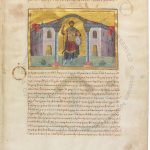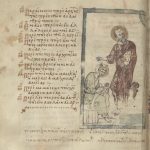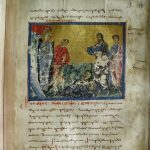- Home
- Articles in category "Blog"
Book Epigrams as Ekphraseis? A Look at the Menologion of Basil II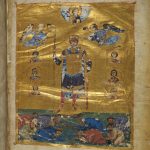 Posted on 21/11/2022Categories: Blog, Ekphrasis, Iliad, Menologion of Basil II, Miniatures, Nicholas Mesarites, Paul the Silentiary, Progymnasmataby Brad HostetlerEpigrams often include descriptive details about the images and things that they adorn. For example, the epigram in a menologion (Oxford, Bodleian Library, gr. th. f. 1) describes the pearls, silver, and gold that decorated the book’s cover; an epigram in a lectionary (Mount Athos, Mone Megistes Lauras Α 103... Read More
Posted on 21/11/2022Categories: Blog, Ekphrasis, Iliad, Menologion of Basil II, Miniatures, Nicholas Mesarites, Paul the Silentiary, Progymnasmataby Brad HostetlerEpigrams often include descriptive details about the images and things that they adorn. For example, the epigram in a menologion (Oxford, Bodleian Library, gr. th. f. 1) describes the pearls, silver, and gold that decorated the book’s cover; an epigram in a lectionary (Mount Athos, Mone Megistes Lauras Α 103... Read More
Carmine finito: Some Evidence of Latin Book Epigrams Posted on 02/09/2022Categories: Blog, Church Fathers, Colophons, Latin book epigrams, Miniatures, Western manuscriptsby Renaat MeestersLatin book epigrams can be found in numerous Western manuscripts. Just as is the case with Byzantine book epigrams, it seems that there is a lot of variation among Latin book epigrams. Some are short and formulaic, others are more refined literary compositions. Similar subgenres (scribe-, patron-, owner-, author-, reader-,... Read More
Posted on 02/09/2022Categories: Blog, Church Fathers, Colophons, Latin book epigrams, Miniatures, Western manuscriptsby Renaat MeestersLatin book epigrams can be found in numerous Western manuscripts. Just as is the case with Byzantine book epigrams, it seems that there is a lot of variation among Latin book epigrams. Some are short and formulaic, others are more refined literary compositions. Similar subgenres (scribe-, patron-, owner-, author-, reader-,... Read More
The Byzantine Reader’s Experience Between Paratexts and Collections of Excerpts: Reading the Iliad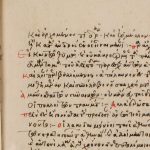 Posted on 09/06/2022Categories: Blog, Education, Excerpts, Iliad, Memory, Readership, Scholiaby Ottavia MazzonThe compilation of anthologies of excerpts, that is to say, the selection and transcription of passages deemed important while reading a text, is a common scholarly practice in Byzantium: excerpts were essential to the way Byzantine intellectuals managed information. Very often, collections of excerpts were compiled close to the moment... Read More
Posted on 09/06/2022Categories: Blog, Education, Excerpts, Iliad, Memory, Readership, Scholiaby Ottavia MazzonThe compilation of anthologies of excerpts, that is to say, the selection and transcription of passages deemed important while reading a text, is a common scholarly practice in Byzantium: excerpts were essential to the way Byzantine intellectuals managed information. Very often, collections of excerpts were compiled close to the moment... Read More
Book Epigrams and Grammar: Verses in and on Grammar Books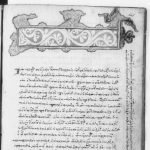 Posted on 24/03/2022Categories: Blog, Education, Grammar, Scholia, Text booksby Febe SchollaertAll epigrams discussed in this blog post are to be found in the Database of Byzantine Book Epigrams (last consulted on 04/03/2022). I am a grammatical textbook, easy to comprehend, easy to take in, focused, plain, clear, written in good order, guiding the answers to the question. For this... Read More
Posted on 24/03/2022Categories: Blog, Education, Grammar, Scholia, Text booksby Febe SchollaertAll epigrams discussed in this blog post are to be found in the Database of Byzantine Book Epigrams (last consulted on 04/03/2022). I am a grammatical textbook, easy to comprehend, easy to take in, focused, plain, clear, written in good order, guiding the answers to the question. For this... Read More
 Posted on 04/04/2023Categories: Blog, Miniatures, Niketas Choniates, Scholia, Textual transmissionby Julián BértolaNiketas Choniates (c. 1155-1217) is one of the top Byzantine intellectuals of all times, a bureaucrat and a writer mostly known for his historiographical work. His History sets off at the beginning of the 12th century with the death and succession of Alexios I Komnenos (1118) and finishes with the... Read More
Posted on 04/04/2023Categories: Blog, Miniatures, Niketas Choniates, Scholia, Textual transmissionby Julián BértolaNiketas Choniates (c. 1155-1217) is one of the top Byzantine intellectuals of all times, a bureaucrat and a writer mostly known for his historiographical work. His History sets off at the beginning of the 12th century with the death and succession of Alexios I Komnenos (1118) and finishes with the... Read More  Posted on 04/04/2023Categories: Blog, Miniatures, Niketas Choniates, Scholia, Textual transmissionby Julián BértolaNiketas Choniates (c. 1155-1217) is one of the top Byzantine intellectuals of all times, a bureaucrat and a writer mostly known for his historiographical work. His History sets off at the beginning of the 12th century with the death and succession of Alexios I Komnenos (1118) and finishes with the... Read More
Posted on 04/04/2023Categories: Blog, Miniatures, Niketas Choniates, Scholia, Textual transmissionby Julián BértolaNiketas Choniates (c. 1155-1217) is one of the top Byzantine intellectuals of all times, a bureaucrat and a writer mostly known for his historiographical work. His History sets off at the beginning of the 12th century with the death and succession of Alexios I Komnenos (1118) and finishes with the... Read More 